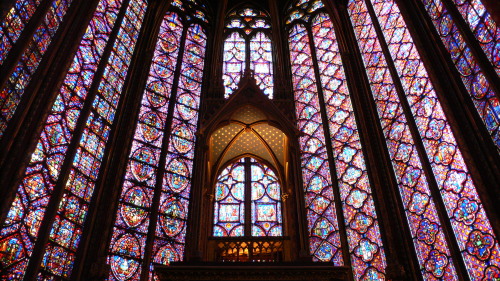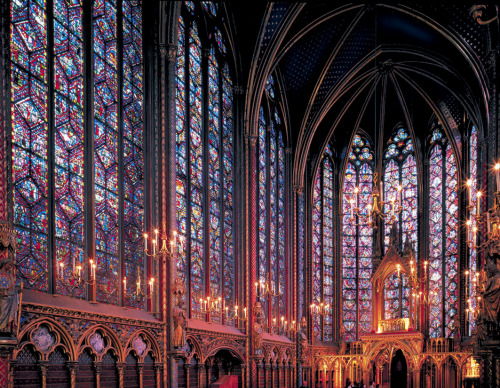Azure Grotto, Naples (1841) By Ivan Aivazovsky

Azure Grotto, Naples (1841) by Ivan Aivazovsky
More Posts from Ancientpansy and Others

Lion of Amphipolis, Greece 4th c. BC
The Bridge House, Perthshire
@castlesofscotland

Bran Castle, Romania (by JK)


The Stained Glass of Sainte-Chapelle
Interior of the upper chapel (looking northeast), Sainte-Chapelle, Paris, France, 1243–1248
This chapel is a masterpiece of the so-called Rayonnant (radiant) style of the High Gothic age, which dominated the second half of the century. It was the preferred style of the royal Parisian court of Saint Louis. Sainte-Chapelle’s architect carried the dissolution of walls and the reduction of the bulk of the supports to the point that some 6,450 square feet of stained glass make up more than than three-quarters of the structure. The emphasis is on the extreme slenderness of the architectural forms and on linearity in general. Although the chapel required restoration in the 19th century (after suffering damage during the French Revolution), it retains most of its original 13th-century stained glass. Approximately 49 feet high and 15 feet wide, they were the largest designed up to their time. (source)

Grand Canyon with Rainbow (1912) by Thomas Moran

“Święty Marcin / Saint Martin” Piotr Stachiewicz 1907





Once the seat of Clan Donald, Armadale Castle on the Isle of Skye was originally built around 1790 and expanded in the Scottish Baronial style in 1815. After a fire in 1855 and later abandonment in 1925, its ruins now stand among 40 acres of gardens, offering a glimpse into its storied past.
scotland.co


Isaac Levitan - "In the Vicinity of the Savvino-Storozhevsky Monastery"
At 40, Franz Kafka (1883-1924), who never married and had no children, was walking through a park one day in Berlin when he met a girl who was crying because she had lost her favourite doll. She and Kafka searched for the doll unsuccessfully.
Kafka told her to meet him there the next day and they would come back to look for her.
The next day, when they had not yet found the doll, Kafka gave the girl a letter "written" by the doll saying "please don't cry. I took a trip to see the world. I will write to you about my adventures."
Thus began a story which continued until the end of Kafka's life.
During their meetings, Kafka read the letters of the doll carefully written with adventures and conversations that the girl found adorable.
Finally, Kafka brought back the doll (he bought one) that had returned to Berlin.
"It doesn't look like my doll at all," said the girl.
Kafka handed her another letter in which the doll wrote:
"my travels have changed me." The little girl hugged the new doll and brought the doll with her to her happy home.
A year later Kafka died.
Many years later, the now-adult girl found a letter inside the doll. In the tiny letter signed by Kafka it was written:
"Everything you love will probably be lost, but in the end, love will return in another way."

-
 neuromancerr liked this · 1 week ago
neuromancerr liked this · 1 week ago -
 originalbonkdonuteggs-blog liked this · 1 week ago
originalbonkdonuteggs-blog liked this · 1 week ago -
 likurg-ever liked this · 1 week ago
likurg-ever liked this · 1 week ago -
 ableedingpromise liked this · 1 week ago
ableedingpromise liked this · 1 week ago -
 midnights-wish reblogged this · 1 week ago
midnights-wish reblogged this · 1 week ago -
 juanvaldescesar reblogged this · 1 week ago
juanvaldescesar reblogged this · 1 week ago -
 juanvaldescesar liked this · 1 week ago
juanvaldescesar liked this · 1 week ago -
 persbaderse liked this · 1 week ago
persbaderse liked this · 1 week ago -
 cosmic-couture liked this · 1 week ago
cosmic-couture liked this · 1 week ago -
 ancientpansy reblogged this · 1 week ago
ancientpansy reblogged this · 1 week ago -
 ancientpansy liked this · 1 week ago
ancientpansy liked this · 1 week ago -
 rfsnyder reblogged this · 1 week ago
rfsnyder reblogged this · 1 week ago -
 rfsnyder liked this · 1 week ago
rfsnyder liked this · 1 week ago -
 palmyre-fallstar liked this · 1 week ago
palmyre-fallstar liked this · 1 week ago -
 warviper69 liked this · 1 week ago
warviper69 liked this · 1 week ago -
 cliffburton reblogged this · 1 week ago
cliffburton reblogged this · 1 week ago -
 venus-de-jalea liked this · 1 week ago
venus-de-jalea liked this · 1 week ago -
 estupefacto-de reblogged this · 1 week ago
estupefacto-de reblogged this · 1 week ago -
 estupefacto-de liked this · 1 week ago
estupefacto-de liked this · 1 week ago -
 dkafterdark liked this · 1 week ago
dkafterdark liked this · 1 week ago -
 king-of-bullshit liked this · 1 week ago
king-of-bullshit liked this · 1 week ago -
 pika-cthuluuuuu reblogged this · 1 week ago
pika-cthuluuuuu reblogged this · 1 week ago -
 juniae liked this · 1 week ago
juniae liked this · 1 week ago -
 magic-in-the-ordinary liked this · 1 week ago
magic-in-the-ordinary liked this · 1 week ago -
 hanna-lulu liked this · 1 week ago
hanna-lulu liked this · 1 week ago -
 beaulesbian reblogged this · 1 week ago
beaulesbian reblogged this · 1 week ago -
 beaulesbian liked this · 1 week ago
beaulesbian liked this · 1 week ago -
 criticalgay reblogged this · 1 week ago
criticalgay reblogged this · 1 week ago -
 bluwoman liked this · 1 week ago
bluwoman liked this · 1 week ago -
 sugarcandytuft reblogged this · 1 week ago
sugarcandytuft reblogged this · 1 week ago -
 sugarcandytuft liked this · 1 week ago
sugarcandytuft liked this · 1 week ago -
 dahliasgloom reblogged this · 1 week ago
dahliasgloom reblogged this · 1 week ago -
 magenta-universe reblogged this · 1 week ago
magenta-universe reblogged this · 1 week ago -
 magenta-universe liked this · 1 week ago
magenta-universe liked this · 1 week ago -
 romanga707 liked this · 1 week ago
romanga707 liked this · 1 week ago -
 jeff-killme liked this · 1 week ago
jeff-killme liked this · 1 week ago -
 mrcr0w liked this · 1 week ago
mrcr0w liked this · 1 week ago -
 oananovicov liked this · 1 week ago
oananovicov liked this · 1 week ago -
 mydeaddad reblogged this · 1 week ago
mydeaddad reblogged this · 1 week ago -
 onearthbriefly reblogged this · 1 week ago
onearthbriefly reblogged this · 1 week ago -
 onearthbriefly liked this · 1 week ago
onearthbriefly liked this · 1 week ago -
 djbalaclava liked this · 1 week ago
djbalaclava liked this · 1 week ago -
 lastoftheptolemies liked this · 1 week ago
lastoftheptolemies liked this · 1 week ago -
 mourning-lily liked this · 1 week ago
mourning-lily liked this · 1 week ago -
 picopepin2 reblogged this · 1 week ago
picopepin2 reblogged this · 1 week ago -
 picopepin liked this · 1 week ago
picopepin liked this · 1 week ago -
 basedkahnum reblogged this · 1 week ago
basedkahnum reblogged this · 1 week ago -
 divez reblogged this · 1 week ago
divez reblogged this · 1 week ago -
 nemmirie reblogged this · 1 week ago
nemmirie reblogged this · 1 week ago -
 just-dont-ask-me-why liked this · 1 week ago
just-dont-ask-me-why liked this · 1 week ago
Old things are always in good repute, present things in disfavor. Tacitus
3 posts